Reactive oxygen species inactivation of surfactant involves structural and functional alterations to surfactant proteins SP-B and SP-C
- PMID: 16443649
- PMCID: PMC1414557
- DOI: 10.1529/biophysj.105.073106
Reactive oxygen species inactivation of surfactant involves structural and functional alterations to surfactant proteins SP-B and SP-C
Abstract
Exposing bovine lipid extract surfactant (BLES), a clinical surfactant, to reactive oxygen species arising from hypochlorous acid or the Fenton reaction resulted in an increase in lipid (conjugated dienes, lipid aldehydes) and protein (carbonyls) oxidation products and a reduction in surface activity. Experiments where oxidized phospholipids (PL) were mixed with BLES demonstrated that this addition hampered BLES biophysical activity. However the effects were only moderately greater than with control PL. These results imply a critical role for protein oxidation. BLES oxidation by either method resulted in alterations in surfactant proteins SP-B and SP-C, as evidenced by altered Coomassie blue and silver staining. Western blot analyses showed depressed reactivity with specific antibodies. Oxidized SP-C showed decreased palmitoylation. Reconstitution experiments employing PL, SP-B, and SP-C isolated from control or oxidized BLES demonstrated that protein oxidation was more deleterious than lipid oxidation. Furthermore, addition of control SP-B can improve samples containing oxidized SP-C, but not vice versa. We conclude that surfactant oxidation arising from reactive oxygen species generated by air pollution or leukocytes interferes with surfactant function through oxidation of surfactant PL and proteins, but that protein oxidation, in particular SP-B modification, produces the major deleterious effects.
Figures
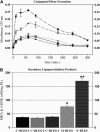

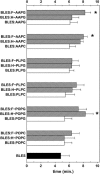





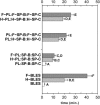

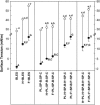

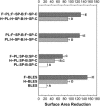
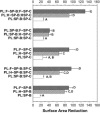
Similar articles
-
Modification of tryptophan and methionine residues is implicated in the oxidative inactivation of surfactant protein B.Biochemistry. 2007 May 8;46(18):5604-15. doi: 10.1021/bi062304p. Epub 2007 Apr 11. Biochemistry. 2007. PMID: 17425286
-
Protein-lipid interactions and surface activity in the pulmonary surfactant system.Chem Phys Lipids. 2006 Jun;141(1-2):105-18. doi: 10.1016/j.chemphyslip.2006.02.017. Epub 2006 Mar 20. Chem Phys Lipids. 2006. PMID: 16600200 Review.
-
Poly(ethylene glycol) (PEG) enhances dynamic surface activity of a bovine lipid extract surfactant (BLES).Colloids Surf B Biointerfaces. 2005 Mar 25;41(2-3):145-51. doi: 10.1016/j.colsurfb.2004.11.012. Epub 2005 Jan 8. Colloids Surf B Biointerfaces. 2005. PMID: 15737540
-
Pulmonary surfactant protein-A (SP-A) restores the surface properties of surfactant after oxidation by a mechanism that requires the Cys6 interchain disulfide bond and the phospholipid binding domain.J Biol Chem. 2003 Jun 6;278(23):20461-74. doi: 10.1074/jbc.M212697200. Epub 2003 Feb 24. J Biol Chem. 2003. PMID: 12600986
-
Surfactant protein B: structure and function.Biol Neonate. 2004;85(4):285-9. doi: 10.1159/000078169. Epub 2004 Jun 8. Biol Neonate. 2004. PMID: 15218284 Review.
Cited by
-
Alveolar Hyperoxia and Exacerbation of Lung Injury in Critically Ill SARS-CoV-2 Pneumonia.Med Sci (Basel). 2023 Nov 1;11(4):70. doi: 10.3390/medsci11040070. Med Sci (Basel). 2023. PMID: 37987325 Free PMC article. Review.
-
Particles in Exhaled Air (PExA): Clinical Uses and Future Implications.Diagnostics (Basel). 2024 May 7;14(10):972. doi: 10.3390/diagnostics14100972. Diagnostics (Basel). 2024. PMID: 38786270 Free PMC article. Review.
-
Experimental lung injury promotes alterations in energy metabolism and respiratory mechanics in the lungs of rats: prevention by exercise.Mol Cell Biochem. 2014 Apr;389(1-2):229-38. doi: 10.1007/s11010-013-1944-8. Epub 2013 Dec 31. Mol Cell Biochem. 2014. PMID: 24378995
-
Establishment of LC-MS methods for the analysis of palmitoylated surfactant proteins.J Lipid Res. 2015 Jul;56(7):1370-9. doi: 10.1194/jlr.D060236. Epub 2015 May 28. J Lipid Res. 2015. PMID: 26022805 Free PMC article.
-
Clinical review: Exogenous surfactant therapy for acute lung injury/acute respiratory distress syndrome--where do we go from here?Crit Care. 2012 Nov 22;16(6):238. doi: 10.1186/cc11512. Crit Care. 2012. PMID: 23171712 Free PMC article. Review.
References
-
- Bachofen, H., and S. Schurch. 2001. Alveolar surface forces and lung architecture. Comp. Biochem. Physiol. A. 129:183–193. - PubMed
-
- Lewis, J. F., and R. Veldhuizen. 2003. The role of exogenous surfactant in the treatment of acute lung injury. Annu. Rev. Physiol. 65:613–642. - PubMed
-
- Possmayer, F. 2004. Physicochemical aspects of pulmonary surfactant. In Fetal and Neonatal Physiology, 3rd ed. R. A. Polin, W. W. Fox, and S. H. Abman, editors. W. B. Saunders, Philadelphia. 1014–1034.
-
- Crouch, E., and J. R. Wright. 2001. Surfactant proteins A and D and pulmonary host defense. Annu. Rev. Physiol. 63:521–554. - PubMed
Publication types
MeSH terms
Substances
LinkOut - more resources
Full Text Sources
Other Literature Sources
Medical

